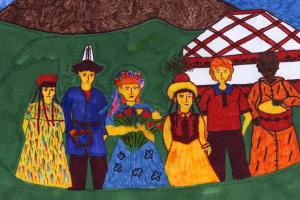Gender action plan at 10
The OSCE Action Plan for the Promotion of Gender Equality is ten years old. This landmark document recognizes that the full and equal participation of women and men is key to achieving peace, prosperity and stability. A review conference on 10-11 July 2014 is taking stock of the progress the OSCE and participating States have made in making gender equality a reality.
Gender equality means equal rights and opportunities for women and men in laws and policies, and equal access to resources and services within families, communities and society. It refers to women and men being able to participate in all spheres of life on an equal footing.
… If gender equality is to become a reality in any area and at any level of society, both men and women will benefit from such a change.
2004 OSCE Action Plan for the Promotion of Gender Equality
The 2004 OSCE Action Plan for the Promotion of Gender Equality is the key OSCE document assigning responsibilities and tasks to all parts of the OSCE and its 57 States in attaining gender equality.
Among its objectives are:
- To ensure all OSCE policies, programmes and activities are gender mainstreamed, in other words, assessing the different implications for women and men in all OSCE planned activities and policies;
- Within the OSCE, developing a professional, gender-sensitive management culture and working environment,
- Supporting the efforts of participating States in achieving gender equality.
EXPLORE: How has the OSCE fared in recruiting more women into its senior management positions in the last ten years?
Peace for all
Social exclusion and violations of human rights can lead to instability and insecurity. Therefore the OSCE recognizes that the equal rights of women and men are essential to fostering peace, sustainable democracy and economic development. This is at the heart of the OSCE’s concept of comprehensive security.
Integrating gender equality and gender-sensitive practices into the security sector is particularly key to ensuring that the rights, needs and interests of both women and men are protected in a fair and non-discriminatory manner.
Over the last decade the OSCE has been raising awareness of the Women, Peace and Security agenda, and of the 43 states worldwide which have launched National Action Plans for implementing UN Security Council Resolution 1325, 27 of these are OSCE participating States.
The Resolution, which was adopted in 2000, recognizes that women, who make up half of the world’s population, are in many ways affected by wars and conflicts differently from men.
“There is increasing agreement that women’s perspectives are crucial for a full understanding of the impact of a conflict and that taking into account women’s conflict experience is essential to establishing lasting peace,” says Ambassador Miroslava Beham, Senior Advisor on Gender Issues. “Adding women in peace processes gives them greater legitimacy as it offers solutions to a broader segment of society.”
LISTEN: Ambassador Miroslava Beham, Senior Advisor on Gender Issues speaks on the progress and challenges in achieving gender equality in the OSCE region:
Roma women: Double discrimination
Attaining gender equality for Roma and Sinti women remains a challenge. Roma as a community face discrimination and racism across the OSCE region, limiting their access to education, employment and social services. However Roma women and girls face discrimination within the Roma communities too usually because of cultural and socially attributed gender roles.
“Because of the patriarchal culture within their community Roma women and girls can be exposed to domestic violence or arranged marriages at a very young age,” says Fana Delija of the Montenegrin NGO Centre for Roma Initiatives. “Yet state institutions can often lack the appropriate mechanisms to effectively address the problem.”
The OSCE Contact Point for Roma and Sinti Issues is working to build the capacity of Roma women activists to serve as role models and help break down gender stereotypes, so that gender equality is enshrined for Roma women and girls both within and outside their community.
Charting the way forward
While there have been successes in advancing the cause of gender equality across OSCE States, there are challenges too, both old and new.
Women are still under-represented in national parliaments (see below). The OSCE Office for Democratic Institutions and Human Rights (ODIHR) is working to remedy this through a range of tailor-made activities to promote internal party democracy and enhance women’s participation in elections.
The OSCE is also reacting to new realities and trends.
Last year the OSCE last year began a new initiative to promote the need to give women a voice in mediation. Mediation is now recognized as the one of the most effective methods of preventing, managing and resolving conflicts but traditionally has been beyond the reach of most women.
In other areas, the OSCE has renewed the focus on empowering women in the economic sphere, recognizing that women have just as much as men to contribute to the labour market. The OSCE is also working to breakdown traditional stereotypes and taboos over gender-based violence by taking this problem out of the private, family realm and putting it on national security agendas.
However to properly measure whether things are moving in the right direction, greater monitoring and evaluation of both the OSCE’s gender mainstreaming and States’ efforts of meeting their gender equality commitments is needed.
This is why on 10-11 July 2014, the OSCE is organizing the Gender Equality Review Conference to take stock of the achievements and plot the way forward.
While the OSCE and its participating States have made much progress in achieving gender equality for women and men, girls and boys, the OSCE has to continue to find and implement new and creative ways to tackle the barriers and challenges that remain to ensure everyone can really contribute to, and enjoy the benefits of peace, security and prosperity.




















